
A mammoth is any species of the extinct elephantid genus Mammuthus. The various species of mammoth were commonly equipped with long, curved tusks. They lived from the late Miocene epoch into the Holocene about 4,000 years ago, and various species existed in Africa, Europe, Asia, and North America. Mammoths are more closely related to living Asian elephants than African elephants.

Proboscidea is a taxonomic order of afrotherian mammals containing one living family (Elephantidae) and several extinct families. First described by J. Illiger in 1811, it encompasses the elephants and their close relatives. Proboscideans include some of the largest known land mammals. The largest land mammal of all time may have been a proboscidean; the elephant Palaeoloxodon namadicus has been estimated to be up to 5.2 m (17.1 ft) at the shoulder and may have weighed up to 22 t, surpassing the paraceratheres, the otherwise largest known land mammals, though this estimate was made based on a single fragmentary femur and is speculative. The largest extant proboscidean is the African bush elephant, with a record of size of 4 m (13.1 ft) at the shoulder and 10.4 t. In addition to their enormous size, later proboscideans are distinguished by tusks and long, muscular trunks, which were less developed or absent in early proboscideans.
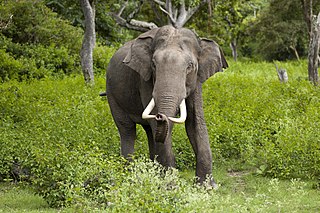
Elephantidae is a family of large, herbivorous proboscidean mammals collectively called elephants and mammoths. These are large terrestrial mammals with a snout modified into a trunk and teeth modified into tusks. Most genera and species in the family are extinct. Only two genera, Loxodonta and Elephas, are living.
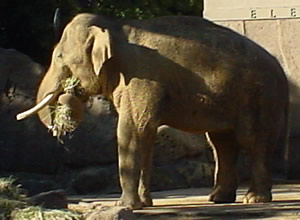
Elephas is one of two surviving genera in the family of elephants, Elephantidae, with one surviving species, the Asian elephant, Elephas maximus. Several extinct species have been identified as belonging to the genus, extending back to the Pliocene era.
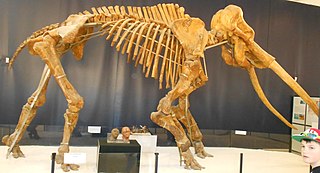
Palaeoloxodon is an extinct genus of elephant. The genus originated in Africa during the Early Pleistocene, and expanded into Eurasia at the beginning of the Middle Pleistocene. The genus contains some of the largest known species of elephants, over 4 metres (13 ft) tall at the shoulders, including the African Palaeoloxodon recki, the European straight-tusked elephant and the South Asian Palaeoloxodon namadicus. P. namadicus has been suggested to be the largest known land mammal by some authors based on extrapolation from fragmentary remains, though these estimates are highly speculative. In contrast, the genus also contains many species of dwarf elephants that evolved via insular dwarfism on islands in the Mediterranean, some only 1 metre (3.3 ft) in height, making them the smallest elephants known. The genus has a long and complex taxonomic history, and at various times, it has been considered to belong to Loxodonta or Elephas, but today is usually considered a valid and separate genus in its own right.

Stegodon is an extinct genus of proboscidean, related to elephants. It was originally assigned to the family Elephantidae along with modern elephants but is now placed in the extinct family Stegodontidae. Like elephants, Stegodon had teeth with plate-like lophs that are different from those of more primitive proboscideans like gomphotheres and mammutids. The oldest fossils of the genus are found in Late Miocene strata in Asia, likely originating from the more archaic Stegolophodon, subsequently migrating into Africa. While the genus became extinct in Africa during the Pliocene, Stegodon remained widespread in South, Southeast and East Asia until the end of the Pleistocene.

Dwarf elephants are prehistoric members of the order Proboscidea which, through the process of allopatric speciation on islands, evolved much smaller body sizes in comparison with their immediate ancestors. Dwarf elephants are an example of insular dwarfism, the phenomenon whereby large terrestrial vertebrates that colonize islands evolve dwarf forms, a phenomenon attributed to adaptation to resource-poor environments and lack of predation and competition.

Palaeoloxodon recki, often known by the synonym Elephas recki is an extinct species of elephant native to Africa and West Asia from the Pliocene or Early Pleistocene to the Middle Pleistocene. During most of its existence, the species represented the dominant elephant species in East Africa. The species is divided into 5 roughly chronologically successive subspecies. While the type and latest subspecies P. recki recki as well as the preceeding P. recki ileretensis are widely accepted to be closely related to Eurasian Palaeoloxodon, the relationships of the other, chronologically earlier subspecies to P. recki recki and P. recki ileretensis are uncertain, with it being suggested they are unrelated and should be elevated to separate species.

The straight-tusked elephant is an extinct species of elephant that inhabited Europe and Western Asia during the Middle and Late Pleistocene. It was larger than any living elephant, with some adult males suggested to reach 3.81–4.2 metres (12.5–13.8 ft) in shoulder height, and 11.3–15 tonnes in weight. Like modern elephants, the straight-tusked elephant lived in herds, flourishing during interglacial periods, when its range would extend as far north as Great Britain. Skeletons found in association with stone tools and wooden spears suggest they were scavenged and hunted by early humans, including Neanderthals. It is the ancestral species of most dwarf elephants that inhabited islands in the Mediterranean.

Palaeoloxodon falconeri is an extinct species of dwarf elephant from the Middle Pleistocene of Sicily and Malta. It is amongst the smallest of all dwarf elephants at only 1 metre (3.3 ft) in height. A member of the genus Palaeoloxodon, it derived from a population of the mainland European straight-tusked elephant.

Mammuthus meridionalis, sometimes called the southern mammoth, is an extinct species of mammoth native to Eurasia, including Europe, during the Early Pleistocene, living from around 2.5 million years ago to 800,000 years ago.

Mammuthus trogontherii, sometimes called the steppe mammoth, is an extinct species of mammoth that ranged over most of northern Eurasia during the Early and Middle Pleistocene, approximately 1.7 million-200,000 years ago. One of the largest mammoth species, it evolved in East Asia during the Early Pleistocene, around 1.8 million years ago, before migrating into North America around 1.5 million years ago, and into Europe during the Early/Middle Pleistocene transition, around 1 to 0.7 million years ago. It was the ancestor of the woolly mammoth and Columbian mammoth of the later Pleistocene.
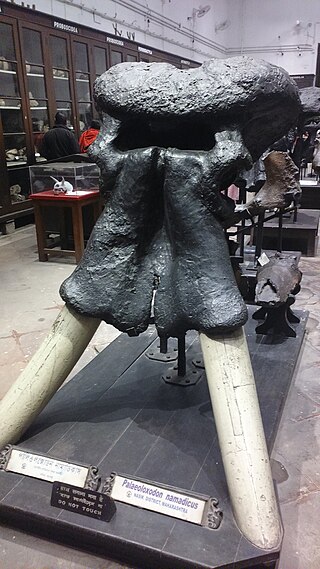
Palaeoloxodon namadicus is an extinct species of prehistoric elephant known from the early Middle to Late Pleistocene of the Indian subcontinent, and possibly also elsewhere in Asia. The species grew larger than any living elephant, and some authors have suggested it to have been the largest known land mammal based on extrapolation from fragmentary remains, though these estimates are speculative.

Mammuthus lamarmorai is a species of dwarf mammoth which lived during the late Middle and Late Pleistocene on the island of Sardinia in the Mediterranean. It has been estimated to have had a shoulder height of around 1.4 metres (4.6 ft). Remains have been found across the western part of the island.

Elephas hysudricus is an extinct elephant species known from the Pleistocene of Asia. It is thought to be ancestral to the living Asian elephant, from which it is distinguished by the molar teeth having a lower crown height and a lower lamellae number. Remains of the species are primarily known from the Indian subcontinent, with the most important remains coming from the Siwalik Hills. The oldest remains of the species in the Siwaliks are placed at around 2.6 million year ago at the beginning of the Early Pleistocene, with the youngest dates in the Siwaliks during the Middle Pleistocene around 0.6 million years ago, though it likely persisted on the subcontinent later than this based on remains found elsewhere. Remains likely attributable to the species are also known from the Levant in Israel and Jordan, dating to the late Middle Pleistocene, likely sometime between 500-100,000 years ago. Isotopic analysis of specimens from the Indian subcontinent suggests that early members of the species were likely primarily grazers, but shifted towards mixed feeding after the arrival of the substantially larger elephant species Palaeoloxodon namadicus to the region. It is suggested to be closely related and possibly ancestral to the extinct Elephas hysudrindicus from the Pleistocene of Java in Indonesia.

Palaeoloxodon mnaidriensis is an extinct species of dwarf elephant belonging to the genus Palaeoloxodon, native to the Siculo-Maltese archipelago during the late Middle Pleistocene and Late Pleistocene. It is derived from the European mainland straight-tusked elephant.
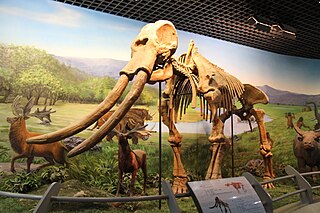
Palaeoloxodon naumanni, occasionally called Naumann's elephant, is an extinct species belonging to the genus Palaeoloxodon found in the Japanese archipelago during the Middle to Late Pleistocene around 330,000 to 24,000 years ago. It is named after Heinrich Edmund Naumann who discovered the first fossils at Yokosuka, Kanagawa, Japan. Fossils attributed to P. naumanni are also known from China and Korea, though the status of these specimens is unresolved, and some authors regard them as belonging to separate species.

Stephanorhinus kirchbergensis, also known as Merck's rhinoceros or the forest rhinoceros, is an extinct species of rhinoceros belonging to the genus Stephanorhinus from the Middle to Late Pleistocene of Eurasia. Its range spanned from western Europe to eastern Asia. Among the last members of the genus, it co-existed alongside Stephanorhinus hemitoechus in the western part of its range.

Elephas planifrons is an extinct species of elephant, known from the Late Pliocene-Early Pleistocene of the Indian subcontinent.
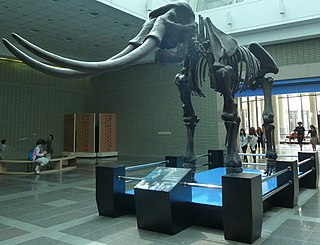
Palaeoloxodon huaihoensis is an extinct species of elephant belonging to the genus Palaeoloxodon known from the Pleistocene of China. It was first named a subspecies of P. naumanni by J. Liu in 1977 based on a partial skeleton from Huaiyuan, Anhui, and was later elevated to species rank by G. Qi in 1999, who also included remains found in the Penghu Channel between the Penghu archipelago and Taiwan. The Penghu Channel remains are suggested to date to the Middle and Late Pleistocene. A mostly complete adult skull from Late Pleistoene Nihewan basin in Hebei may be referrable to this species. The body size is very large, comparable to Indian Palaeoloxodon namadicus and the European straight-tusked elephant. In comparison to Indian P. namadicus, the postcranial skeleton is substantially more robust, and greatly resembles that of P. antiquus. The morphology of IVPP V4443 is also overall more similar to that of P. antiquus than P. namadicus, but the parietal-occipital crest at the top of the skull displays a very robust morphology closer to that of P. namadicus. The oldest remains of Palaeoloxodon in North China date to the early Middle Pleistocene, around 700,000 years ago. The latest dates for Palaeoloxodon in China are from the Late Pleistocene, and a Holocene survival is not substantiated. Mitochondrial genomes retrieved from Chinese Palaeoloxodon individuals from North China reveal that like the European P. antiquus, they harboured mitochondrial lineages derived from those of African forest elephants as a result of hybridisation with that species prior to Palaeoloxodon leaving Africa.


















